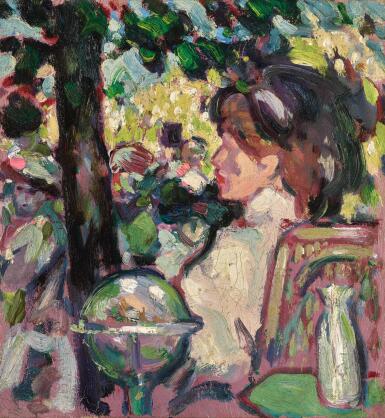Scottish Art
Scottish Art

JOHN DUNCAN FERGUSSON, R.B.A. | THE OPEN AIR FÊTE
Auction Closed
September 18, 02:04 PM GMT
Estimate
60,000 - 80,000 GBP
Lot Details
Description
JOHN DUNCAN FERGUSSON, R.B.A.
1874-1961
THE OPEN AIR FÊTE
oil on canvas
35.5 by 33cm., 14 by 13in.
The Open-Air Fête depicts a terrace outside the Pavillon d’Armenonville, in the Parc de Bagatelle near the Champs Élysée. Vigorous brushwork, applied en plein air, combines with a lively palette to convey a sense of excitement. A seated woman wearing a fashionable black hat assumes the role of a flâneuse as she observes the gaiety of the sun-lit scene before her. While the subject matter is reminiscent of famous works such as Edouard Manet’s Music in the Tuileries Gardens (1862, The National Gallery, London) or Auguste Renoir’s Dance at the Moulin de la Galette (1876, Musée d’Orsay), The Open-Air Fête is much more modern in style, with black outlines, bold colour and energetic handling of paint all demonstrating the heavy influence of the French Post-Impressionist and Fauvist painters.
The Open-Air Fête was painted in 1907, the year that Fergusson relocated permanently to Paris. Scotland and France have strong historical ties, and after his move, Fergusson referred to this when he declared: ‘Vive la France. And let’s not forget, ever, the Auld Alliance.’ (M. Morris, The Art of J.D. Fergusson, p.53). Of the four Scottish Colourists, Fergusson’s connection with France was by far the deepest and most enduring. He had visited Paris several times previously, often with fellow Colourist Samuel John Peploe, and had studied at the Académies of Colorossi and Julian. Fergusson was enthralled by Parisian life and the French Avant-Garde tendencies, citing Manet and Monet as ‘painters who fixed our [his and Peploe’s] direction.’ Following his relocation, he quickly began to move in Modernist circles that included Henri Matisse, Pablo Picasso and André Derain. Fergusson wrote that ‘I had been accepted by the people I had most respect for. As an artist nothing could be more important.’ (M. Morris, The Art of J.D Fergusson, p.54).
Paris was the world-centre of culture at the time, and attracted writers, dancers and poets as well as artists from across the globe. This created a Bohemian atmosphere that was particularly tangible at Montparnasse, where Fergusson lived and worked. He thrived in this milieu and welcomed the exchange of ideas that occurred between creatives and intellectuals. Regarding life in Montparnasse, Fergusson wrote: ‘Life is how it should be and I was very happy. The Dome, so to speak, round the corner; l’Avenue quite near; the concert Ronge not far away- I was very much interested in music; the Luxembourg Gardens to sketch in; Colorassi’s class if I wanted to ask for a model. In short everything a young painter could want…’ (J. Geddes and M. Morris, Café Drawings in Edwardian Paris from the Sketch-Books of J.D. Fergusson, 1974, p.8). Anne Estelle Rice, an American artist and illustrator who Fergusson had met at in Paris in 1907, also contributed to his contentedness, as the pair had become lovers. The woman in The Open-Air Fête is probably based on Fergusson’s many sketches of her.
